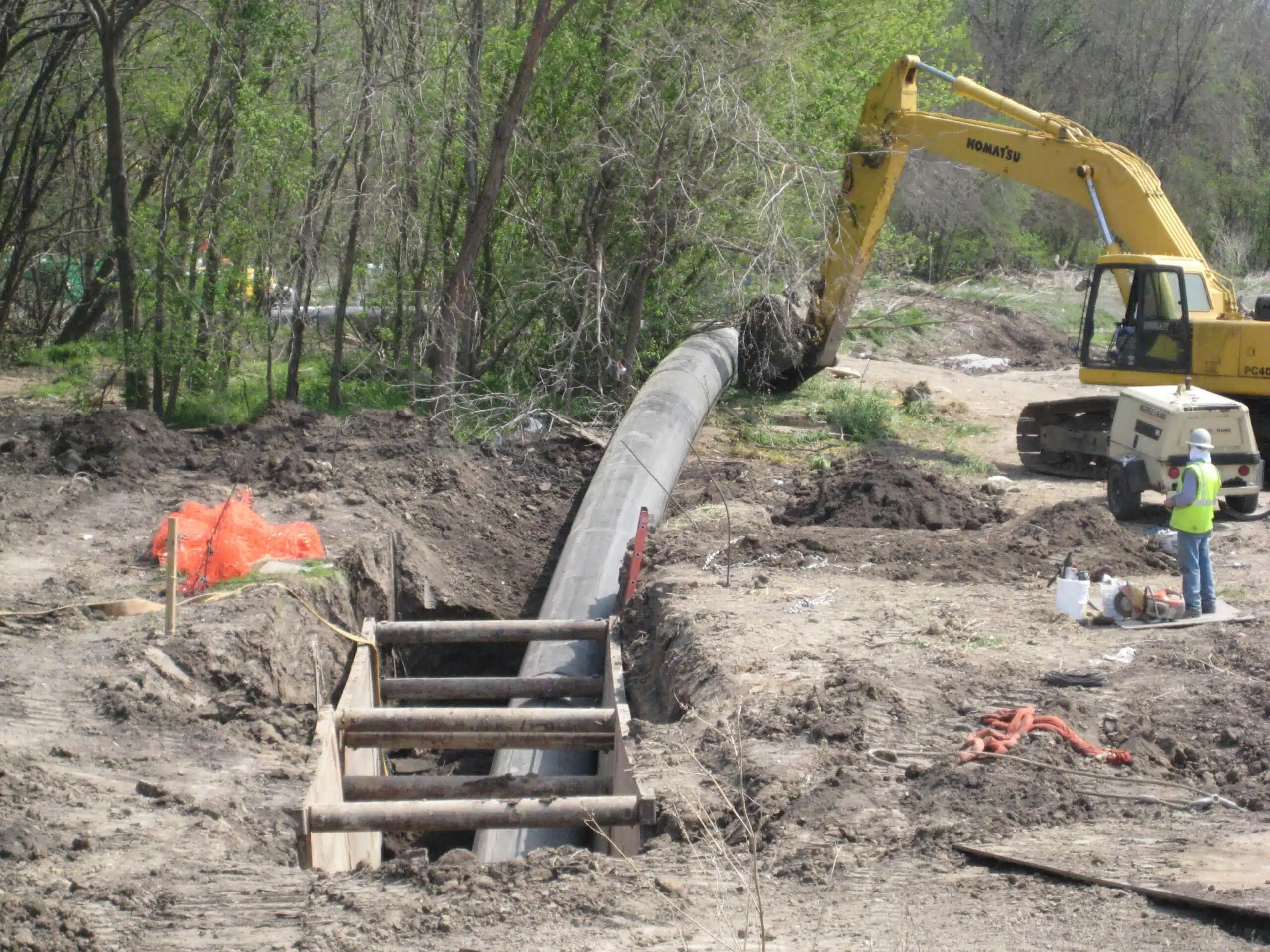- December 6, 2023
- Perspectives, Trending Topics
Pipe Bursting: A Quick and Easy Solution to Water and Sanitary Sewer Line Replacement


Marty Paris, PE
Trenchless Technology Practice Leader

Eli Puente, PE
Civil Engineer
Trenchless technology is a rapidly growing sector within the construction and civil engineering industry due to its minimal disruption to the surrounding environment, businesses, residences, and traffic. Pipe bursting is a trenchless methods used to replace and rehabilitate existing sanitary sewer or water lines. Read on to discover the benefits, capabilities, and limitations of pipe bursting and how it is changing the future of utility installations.
What is Pipe Bursting?
Pipe bursting is a trenchless technology method that allows contractors to replace existing sanitary sewer or water lines by pulling a specialized bursting head through the old pipe. As the bursting head splits and expands the old pipe, the new pipe follows and takes its place. This technique is an efficient way to replace a damaged, aging, or undersized sewer or water line, saving time and resources and causing minimal disruption.
What Makes Pipe Bursting Unique?
Efficient Installation
Because pipe bursting does not entail extensive digging and site disruption, installation timelines are much shorter than with traditional methods. This translates into cost savings and brings water/wastewater utilities back online for the community faster. We have found that projects utilizing pipe bursting methods can reach completion up to 4.5 times quicker than with other methods, such as open cut installation.
Dependable Pipe Design
What makes pipe bursting such a unique method is the pipe design itself. The replacement pipe is one long fully fused polyethylene pipe with no joints. If a 500-foot existing utility pipe needs to be replaced, a 500-foot replacement pipe is created and pulled into place
Typically, with open cut methods, contractors install 20-foot-long segments of pipes and then connect them with gasketed ends which can lead to leaks over time. Through proper execution, pipe bursting drastically reduces this possibility as the fused joints are just as strong as the pipe itself.
Proper Preparation
Although the concept of replacing a pipe within its own envelope may seem simple, topographic survey and subsurface research is still critical. Some owners forgo these steps of utility replacement and construct plans developed using only geographic information system mapping and aerials to save on costs and time. This may work with other utility replacement methods and open rural spaces, but conducting surveys is an essential step when choosing the pipe bursting method. To fully understand the site conditions they are working with, contractors should examine the following major properties:
- Existing line material
- Depth
- Condition
- Maintenance history
- Surrounding utilities
- Soil conditions
When Should Pipe Bursting Be Used?
Upgrading Pipe Sizes
The pipe bursting method provides utility owners the option of keeping the new pipe the same size as the original utility pipe or increasing it by one to two pipe sizes. For example, if the pipe is originally six inches in diameter, developers can upgrade it to an eight- or 10-inch pipe, depending on local clearances and regulations on the depth of utility pipes.
Minimal Environmental Disruption
Pipe bursting is best for replacing pipelines in environmentally sensitive areas—such as wetlands, roads, or residential neighborhoods with established structures over pipelines. Pulling the pipe through an existing utility requires less excavation, causing less surface disruption and minimizing the impact construction has on the surrounding environment and community.
What Should Be Considered When Using Pipe Bursting Methods?
Pipeline Depth
Ground heave can occur when the pipe burst is shallow or in very stiff soils, forcing most of the displacements upwards. To avoid ground heave, contractors need to ensure there are 10 inches of soil cover for every inch of upsize, including the diameter of the bursting head.
For example, if a contractor replaces a six-inch pipe with another six-inch pipe, there must be at least 20 use inches of soil cover despite the pipe size not changing. This is due to the bursting head being larger than the pipes themselves. If there is not proper soil cover, the surrounding landscape, including driveways, sidewalks, yards, and more, can feel the effects of upheaval.
Working Around Existing Utilities
When pipe bursting an existing utility line, some residents or businesses will have their utility service temporarily interrupted. It is up to the contractor to set up a temporary bypass line to maintain sewer and water service.
Pipe bursting technology is still in its infancy. As trenchless technology continues to evolve, we expect that efficient and reliable construction methods like pipe bursting will continue being adopted to solve pipeline problems.
About the Authors

Marty Paris, PE
Marty is a Trenchless Technology Practice Leader with more than 30 years of experience in the design of water and wastewater infrastructure and rehabilitation projects. He has worked on over 200 miles of large- and small-diameter water and wastewater pipeline projects ranging from six-inch to 120-inch and has assisted multiple municipalities with planning, design, and construction phases. He understands all project challenges and issues, ranging from the operations level to the administrative level. His experience includes 200,000 linear feet of trenchless replacement/rehabilitation methods, including cured-in-place, pipe bursting, horizontal directional drilling, microtunneling, fold and form, slip lining, tunneling, and horizontal auger boring.

Eli Puente, PE
Eli has more than eight years of experience working with trenchless technology methods—primarily pipe bursting. He has extensive experience managing and designing water/wastewater pipeline replacement and rehabilitation projects, including large-diameter conveyance and distribution projects and small-diameter neighborhood rehab projects.
